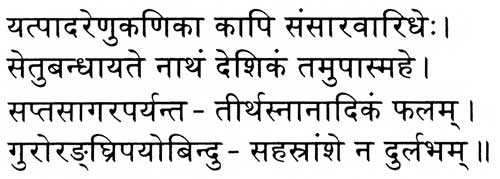Shri Guru Gita: Interactive Sanskrit Course
~ Verse 44 ~
Even a few particles of dust from my Guru’s feet
are enough to build a bridge for me to cross
over the vast ocean of samsara.
Even one–thousandth part of a single drop of
water that has touched the Guru’s feet equals
the boon of bathing in all of the holy waters
across the seven seas. To the Guru I bow.

| Yat paada renu kanikaa | |
| yut paa – pu ray – noo ku – nee – kaa | |
| Note: Renu means dust. | |
| kaapi samsaara | |
| kaa – pee sum – saa – ru | |
| Note: Samsaara is the flowing together of the objective world ('sr' = to flow and 'sam' = together) into the wheel of cyclic existence, and the cycle of rebirth known as transmigration. | |
| vaaridheh | |
| vaa – ri – dhay | |
| Note: Vaaridheh means ocean. | |
| glue... | |
| Yat paada renu kanikaa, kaapi samsaara vaaridheh | |
| Setu bandhaa | |
| say – too bun – dhaa | |
Note: if you do hatha yoga, you'll be familiar with this word from setubandhaasana - the bridge pose. Setubandhaa means bridge.
|
|
| yate naatham | |
| yu – tay naa – thum | |
| Note: Natha means lord. We have seen this word in verse 42 and will see it in verse 59 again, where it is used as mannaatha – my lord. | |
| deshikam tam | |
| day – shee – kum tum | |
| upaasmahe | |
| oo – paas – mu – hay | |
| Note: Upaasmahe is a particularly lovely form of the word to worship. The root upa means to sit near, so it conveys the sense of an intimate connection with the Guru. The ancient scriptures called the Upanishads are also derived from this root word. | |
| glue... | |
| Setu bandhaayate naatham, deshikam tam upaasmahe | |
| Sapta saagara | |
| sup – tu saa – gu – ru | |
| Note: Sapta means seven; saagara means ocean or sea. Sapta is ofen used to mean a long and great celebration, with feasting or chanting and dancing, and often is held for an entire week. Sapta is seven – hence the idea of engaging in a specific sadhana for 7 days. | |
| paryanta | |
| pur – yun – tu | |
| tirtha snaanaadikam | |
| teer – thu snaa – naa – dee – kum | |
Note: As in verses 8 and 10, here we again see tirtha, meaning a place of pilgrimage. (and v. 106 coming up). |
|
| phalam | |
| phu – lum | |
| Note: Phalam was one of our keywords in verse 8, and we'll see it several times later in the Gita as well. It means fruit, and carries the connotation of something being fruitful or beneficial for one's life and sadhana. | |
| glue... | |
| Sapta saagara paryanta, tirtha snaanaadikam phalam | |
| Guror anghri | |
| goo – ror un – ghree | |
| Note: Anghri is yet another name for the feet of the Guru. | |
| payo bindu | |
| pu – yo bin – doo | |
| Note: Mark often speaks of the bindus in the subtle body - these are drops, and this is the literal meaning of the word bindu, as in 'even a single drop'. | |
| sahasraamshe na durlabham | |
| su – hu – sraam – shay nu door – lu –bhum | |
| Note: Sahasraa means thousand. You may have heard this word as the name of the seventh chakra at the crown of the head - so named because it has one thousand petals. As we saw in verse 4, durlabham means difficult. Na durlabham means not difficult. | |
| glue... | |
| Guror anghri payo bindu, sahasraamshe na durlabham | |
| Now repeat the entire verse all together: | |
| Yat paada renu kanikaa, kaapi samsaara vaaridheh; Setu bandhaayate naatham, deshikam tam upaasmahe. Sapta saagara paryanta, tirtha snaanaadikam phalam; Guror anghri payo bindu, sahasraamshe na durlabham. | |
| and repeat it, concentrating on the keywords: | |
| Yat paada renu kanikaa, kaapi samsaara vaaridheh; Setu bandhaayate naatham, deshikam tam upaasmahe. Sapta saagara paryanta, tirtha snaanaadikam phalam; Guror anghri payo bindu, sahasraamshe na durlabham. | |
| Even a few particles of dust from my Guru’s feet are enough to build a bridge for me to cross over the vast ocean of samsara. Even one–thousandth part of a single drop of water that has touched the Guru’s feet equals the boon of bathing in all of the holy waters across the seven seas. To the Guru I bow. | |
